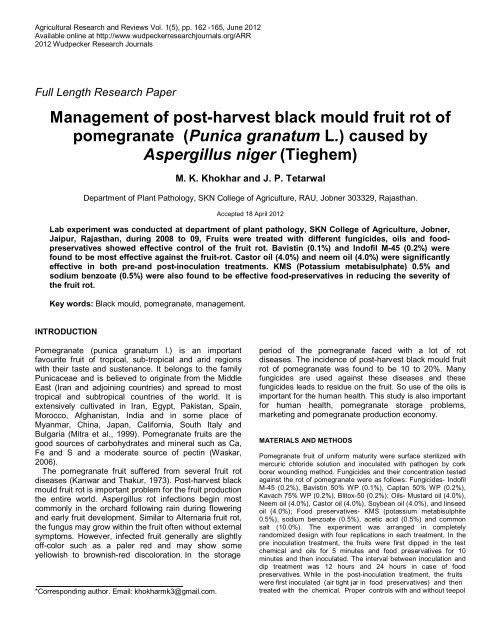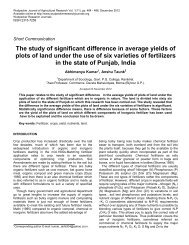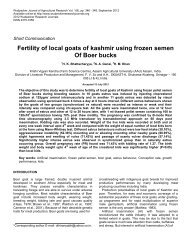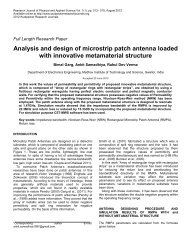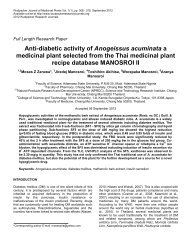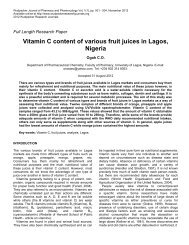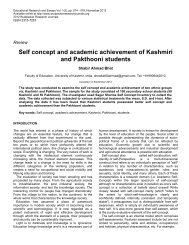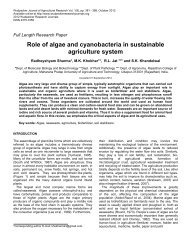Management of post-harvest black mould fruit rot of pomegranate ...
Management of post-harvest black mould fruit rot of pomegranate ...
Management of post-harvest black mould fruit rot of pomegranate ...
You also want an ePaper? Increase the reach of your titles
YUMPU automatically turns print PDFs into web optimized ePapers that Google loves.
Agricultural Research and Reviews Vol. 1(5), pp. 162 -165, June 2012Available online at http://www.wudpeckerresearchjournals.org/ARR2012 Wudpecker Research JournalsFull Length Research Paper<strong>Management</strong> <strong>of</strong> <strong>post</strong>-<strong>harvest</strong> <strong>black</strong> <strong>mould</strong> <strong>fruit</strong> <strong>rot</strong> <strong>of</strong><strong>pomegranate</strong> (Punica granatum L.) caused byAspergillus niger (Tieghem)M. K. Khokhar and J. P. TetarwalDepartment <strong>of</strong> Plant Pathology, SKN College <strong>of</strong> Agriculture, RAU, Jobner 303329, Rajasthan.Accepted 18 April 2012Lab experiment was conducted at department <strong>of</strong> plant pathology, SKN College <strong>of</strong> Agriculture, Jobner,Jaipur, Rajasthan, during 2008 to 09, Fruits were treated with different fungicides, oils and foodpreservativesshowed effective control <strong>of</strong> the <strong>fruit</strong> <strong>rot</strong>. Bavistin (0.1%) and Ind<strong>of</strong>il M-45 (0.2%) werefound to be most effective against the <strong>fruit</strong>-<strong>rot</strong>. Castor oil (4.0%) and neem oil (4.0%) were significantlyeffective in both pre-and <strong>post</strong>-inoculation treatments. KMS (Potassium metabisulphate) 0.5% andsodium benzoate (0.5%) were also found to be effective food-preservatives in reducing the severity <strong>of</strong>the <strong>fruit</strong> <strong>rot</strong>.Key words: Black <strong>mould</strong>, <strong>pomegranate</strong>, management.INTRODUCTIONPomegranate (punica granatum l.) is an importantfavourite <strong>fruit</strong> <strong>of</strong> tropical, sub-tropical and arid regionswith their taste and sustenance. It belongs to the familyPunicaceae and is believed to originate from the MiddleEast (Iran and adjoining countries) and spread to mosttropical and subtropical countries <strong>of</strong> the world. It isextensively cultivated in Iran, Egypt, Pakistan, Spain,Morocco, Afghanistan, India and in some place <strong>of</strong>Myanmar, China, Japan, California, South Italy andBulgaria (Mitra et al., 1999). Pomegranate <strong>fruit</strong>s are thegood sources <strong>of</strong> carbohydrates and mineral such as Ca,Fe and S and a moderate source <strong>of</strong> pectin (Waskar,2006).The <strong>pomegranate</strong> <strong>fruit</strong> suffered from several <strong>fruit</strong> <strong>rot</strong>diseases (Kanwar and Thakur, 1973). Post-<strong>harvest</strong> <strong>black</strong><strong>mould</strong> <strong>fruit</strong> <strong>rot</strong> is important problem for the <strong>fruit</strong> productionthe entire world. Aspergillus <strong>rot</strong> infections begin mostcommonly in the orchard following rain during floweringand early <strong>fruit</strong> development. Similar to Alternaria <strong>fruit</strong> <strong>rot</strong>,the fungus may grow within the <strong>fruit</strong> <strong>of</strong>ten without externalsymptoms. However, infected <strong>fruit</strong> generally are slightly<strong>of</strong>f-color such as a paler red and may show someyellowish to brownish-red discoloration. In the storage*Corresponding author. Email: khokharmk3@gmail.com.period <strong>of</strong> the <strong>pomegranate</strong> faced with a lot <strong>of</strong> <strong>rot</strong>diseases. The incidence <strong>of</strong> <strong>post</strong>-<strong>harvest</strong> <strong>black</strong> <strong>mould</strong> <strong>fruit</strong><strong>rot</strong> <strong>of</strong> <strong>pomegranate</strong> was found to be 10 to 20%. Manyfungicides are used against these diseases and thesefungicides leads to residue on the <strong>fruit</strong>. So use <strong>of</strong> the oils isimportant for the human health. This study is also importantfor human health, <strong>pomegranate</strong> storage problems,marketing and <strong>pomegranate</strong> production economy.MATERIALS AND METHODSPomegranate <strong>fruit</strong> <strong>of</strong> uniform maturity were surface sterilized withmercuric chloride solution and inoculated with pathogen by corkborer wounding method. Fungicides and their concentration testedagainst the <strong>rot</strong> <strong>of</strong> <strong>pomegranate</strong> were as follows: Fungicides- Ind<strong>of</strong>ilM-45 (0.2%), Bavistin 50% WP (0.1%), Captan 50% WP (0.2%),Kavach 75% WP (0.2%), Blitox-50 (0.2%); Oils- Mustard oil (4.0%),Neem oil (4.0%), Castor oil (4.0%), Soybean oil (4.0%), and linseedoil (4.0%); Food preservatives- KMS (potassium metabisulphite0.5%), sodium benzoate (0.5%), acetic acid (0.5%) and commonsalt (10.0%). The experiment was arranged in completelyrandomized design with four replications in each treatment. In thepre inoculation treatment, the <strong>fruit</strong>s were first dipped in the testchemical and oils for 5 minutes and food preservatives for 10minutes and then inoculated. The interval between inoculation anddip treatment was 12 hours and 24 hours in case <strong>of</strong> foodpreservatives. While in the <strong>post</strong>-inoculation treatment, the <strong>fruit</strong>swere first inoculated (air tight jar in food preservatives) and thentreated with the chemical. Proper controls with and without teepol
163 Agric. Res. Rev.Table 1: Effect <strong>of</strong> pre-inoculation treatment with fungicides on severity <strong>of</strong> <strong>black</strong> <strong>mould</strong> <strong>fruit</strong> <strong>rot</strong> <strong>of</strong><strong>pomegranate</strong> <strong>fruit</strong>s incubated after 3 rd and 6 th days at 25+1 0 CFungicides Concentration (%) Aspergillus nigerSeverity* (%)3 rd days afterinoculation6 th days afterinoculationInd<strong>of</strong>il M-45 0.2 4.60 6.00Bavistin 50% WP 0.1 3.75 4.25Captan 50% WP 0.2 5.20 7.00Kavach 75% WP 0.2 6.09 9.00Blitox-50 0.2 8.50 10.50Control - 10.00 20.50SEm+ - 0.15 0.26CD at 5% - 0.44 0.78*Average <strong>of</strong> four replicationsTable 2: Effect <strong>of</strong> <strong>post</strong>-inoculation treatment with fungicides on severity <strong>of</strong> <strong>black</strong> <strong>mould</strong> <strong>fruit</strong> <strong>rot</strong> <strong>of</strong><strong>pomegranate</strong> <strong>fruit</strong>s incubated after 3 rd and 6 th days at 25+1 0 CFungicides Concentration (%) Aspergillus nigerSeverity* (%)3 rd days afterinoculationInd<strong>of</strong>il M-45 0.2 6.00 8.00Bavistin 50% WP 0.1 5.00 7.50Captan 50% WP 0.2 7.50 9.25Kavach 75% WP 0.2 8.25 10.50Blitox-50 0.2 9.00 11.50Control - 11.00 21.50SEm+ - 0.20 0.29CD at 5% - 0.58 0.87*Average <strong>of</strong> four replications6 th days afterinoculationwere also maintained. The method <strong>of</strong> inoculation <strong>of</strong> <strong>pomegranate</strong><strong>fruit</strong>s, their incubation at 25+1 0 C and the disease assessment wererecorded, formula suggested by Mayee and Datar (1986).Sum <strong>of</strong> all numerical ratingsSeverity (%) = -------------------------------------------- x 100Number <strong>of</strong> <strong>fruit</strong>s assessed X Maximum disease ratingThe severity was recorded on the basis <strong>of</strong> per cent <strong>fruit</strong> area.RESULTS AND DISCUSSIONAll the fungicides were found significantly superior inreducing the disease severity as compared to control inthe pre and <strong>post</strong> inoculation treatment both in 3 rd and 6 th day<strong>of</strong> inoculation (Table 1 and 2). Bavistin proved to be themost effective followed by Ind<strong>of</strong>il M-45, Captan, Kavach andBlitox-50. Similar results were also observed by differentfungicides like Bavistin, Ind<strong>of</strong>il M-45, Blitox, Captan andKavach etc. have been found effective in checking thestorage <strong>rot</strong>s <strong>of</strong> citrus <strong>fruit</strong>s caused by different fungalpathogen (Dar and Mukhopadhayya, 197l; Lal et al., 1981;Majumdar and Pathak, 1995; Gour and Khatri, 1995; andKumar et al., 2005). However, the severity was significantlyreduced with all the oils tried after 6 th days <strong>of</strong> inoculation(Table 3 and 4). Castor oil was significantly mosteffective followed by neem oil, linseed oil, mustard oil andsoybean tried in controlling the <strong>rot</strong>, in the pre-inoculationtreatment 6 th days after inoculation. Similar result werealso observed by Castor oil has been also reported to beeffective against several <strong>fruit</strong> <strong>rot</strong>s by Pathak et al., 1971;Khatri and Godara, 1999). Efficacy <strong>of</strong> neem oil found tobe effective against <strong>rot</strong> may be due to presence <strong>of</strong>Nimbicidin an antifugal substance (Rawat, 1993) wasreported to inhibit the growth <strong>of</strong> Aspergillus niger causing<strong>fruit</strong> <strong>rot</strong>s in citrus, papaya and mango. The severity wassignificantly reduced with all the food preservatives triedon 6 th day <strong>of</strong> inoculation (Table 5 and 6). However,
Khokhar and Tetarwal 164Table 3: Effect <strong>of</strong> pre-inoculation treatment with oils on severity <strong>of</strong> <strong>black</strong> <strong>mould</strong> <strong>fruit</strong> <strong>rot</strong> <strong>of</strong><strong>pomegranate</strong> <strong>fruit</strong>s incubated after 3 rd and 6 th days at 25+1 0 COils Concentration (%) Aspergillus nigerSeverity* (%)3 rd days afterinoculation6 th days afterinoculationMustard oil 4.0 8.00 12.50Neem oil 4.0 6.50 9.50Castor oil 4.0 4.50 6.75Soybean oil 4.0 8.50 13.50Linseed oil 4.0 9.50 16.50Control - 10.50 20.00SEm+ - 0.20 0.34CD at 5% - 0.58 0.90*Average <strong>of</strong> four replicationsTepol used as solubilizing agent in each oilTable 4: Effect <strong>of</strong> <strong>post</strong>-inoculation treatment with oils on severity <strong>of</strong> <strong>black</strong> <strong>mould</strong> <strong>fruit</strong> <strong>rot</strong> <strong>of</strong><strong>pomegranate</strong> <strong>fruit</strong>s incubated after 3 rd and 6 th days at 25+1 0 COils Concentration (%) Aspergillus nigerSeverity* (%)3 rd days afterinoculation6 th days afterinoculationMustard oil 4.0 9.50 12.50Neem oil 4.0 8.00 11.50Castor oil 4.0 5.00 7.50Soybean oil 4.0 12.50 18.50Linseed oil 4.0 10.50 17.50Control - 11.00 22.00Sem+ - 0.25 0.41CD at 5% - 0.75 1.20*Average <strong>of</strong> four replicationsTepol used as solubilizing agent in each oilTable 5: Effect <strong>of</strong> pre-inoculation treatment with food preservatives on severity <strong>of</strong> <strong>black</strong> <strong>mould</strong> <strong>fruit</strong> <strong>rot</strong> <strong>of</strong><strong>pomegranate</strong> <strong>fruit</strong>s incubated after 3 rd and 6 th days at 25+1 0 CFood preservatives Concentration (%) Aspergillus nigerSeverity* (%)3 rd days afterinoculation6 th days afterinoculationPotassium0.5 7.50 10.30metabisulphiteSodium benzoate 0.5 9.50 11.50Acetic acid 0.5 8.00 12.00Common salt 10.0 9.50 12.50Control - 11.50 21.50SEm+ - 0.19 0.29CD at 5% - 0.57 0.87*Average <strong>of</strong> four replications
165 Agric. Res. Rev.Table 6: Effect <strong>of</strong> <strong>post</strong>-inoculation treatment with food preservatives on severity <strong>of</strong> <strong>black</strong> <strong>mould</strong> <strong>fruit</strong><strong>rot</strong> <strong>of</strong> <strong>pomegranate</strong> <strong>fruit</strong>s incubated after 3 rd and 6 th days at 25+1 0 CFood preservatives Concentration (%) Aspergillus nigerSeverity* (%)3 rd days afterinoculation6 th days afterinoculationPotassium0.5 8.50 11.00metabisulphiteSodium benzoate 0.5 9.00 11.50Acetic acid 0.5 10.00 15.50Common salt 10.0 10.50 16.50Control - 12.50 22.00SEm+ - 0.20 0.30CD at 5% - 0.57 0.85*Average <strong>of</strong> four replicationspotassium metabisulphite was significantly better overcommon salt, but was at par with sodium benzoate incontrolling the <strong>rot</strong> on 6 th days after inoculation. Similarresults were also observed by Siddiqui et al., 1987;Mehta et al., 1986 and Premi et al., 1999).ACKNOWLEDGEMENTThe authors would like to thank the Head Department <strong>of</strong>Plant pathology and Dean, SKN college <strong>of</strong> Agriculture,Jobner, jaipur for providing necessary facilities.REFERENCESDar GN, Mukhopadhyay S (1977). P<strong>rot</strong>ective action <strong>of</strong> some fungicidesagainst apple <strong>rot</strong>. Current Sci. 46: 278-279.Gour VK, Khatri NK (1995). Fungicidal management <strong>of</strong> <strong>fruit</strong> <strong>rot</strong> in datepalm. Indian J. <strong>of</strong> Myco. and Plant Path.. 25: 135.Kanwar ZS, Thakur DP (1973). Some new <strong>fruit</strong> <strong>rot</strong>s <strong>of</strong> <strong>pomegranate</strong> inHaryana. Sci and Culture. 36: 274-276.Khatri NK, Godara SL (1999). Support Resource Material RefresherCourse on ‘<strong>Management</strong> <strong>of</strong> Post-Harvest Disease <strong>of</strong> Fruits’. 9-21August, 1999. Academic Staff College Cum Distance EducationCentre, RAU, Bikaner, ASC Publication, 8: 227.Kumar MKP, Nargund VB, Basha CRJ (2005). Effect <strong>of</strong> noveltreatments on <strong>post</strong> <strong>harvest</strong> diseases <strong>of</strong> mango (Mangifera indica L.).Mysore J. <strong>of</strong> Agri Sci. 39: 474-479.Lal B, Arya A, Rai RN (1981). A new s<strong>of</strong>t-<strong>rot</strong> <strong>of</strong> ber caused byPhomopsis natsume and its chemical control. Indian Phytopath. 34:361-363.Majumdar VL, Pathak VN (1995). Control <strong>of</strong> <strong>fruit</strong> <strong>rot</strong> <strong>of</strong> guava bychemicals. Indian J. Myco. and Plant Path. 25: 135.Mayee CD, Datar VV (1986). Phytopathmetry Tech. Bull. I (SpecialBulletin-3). Maradhawada Agricultural University. Prabhani, pp. 55.Mehta N, Sandooja JK, Madaan RL, Yamdagni R (1986). Role <strong>of</strong>different chemicals in mango malformation and related physiologicalfactors. Pesticides. 20: 17-18.Mitra SK, Farooq AA, Sadhu MK (1999). Tropical Horti : NayaPrakashan, Kolkata, 1: 338-343.Pathak VN, Goyal JP, Sharma HC (1971). Screening trial for control <strong>of</strong>Diplodia and Rhizopus <strong>rot</strong>s <strong>of</strong> mango <strong>fruit</strong>s. Plant Dis. Repo. 55: 752.Premi BR, Maini SB, Sethi V (1999). Effect <strong>of</strong> steeping preservation inthe quality <strong>of</strong> Aonla <strong>fruit</strong>s during storage. Indian J. Food Sci.Technol., 36: 244-247.Rawat NS (1993). Neem products and their pesticidal characteristics.Everyman's Sci,. 28: 194-199.Siddiqui S, Sandooja JK, Mehta N, Yamadagni R (1987). Biochemicalchanges during malformation in mango cultivars as influenced byvarious chemicals. Pesticides. 21: 17-19.Waskar DP (2006). Pomegranate (Punica granatum). Advances in AridHorti, Vol. II, International Book Distributing Company, Lucknow. pp.375-394.


